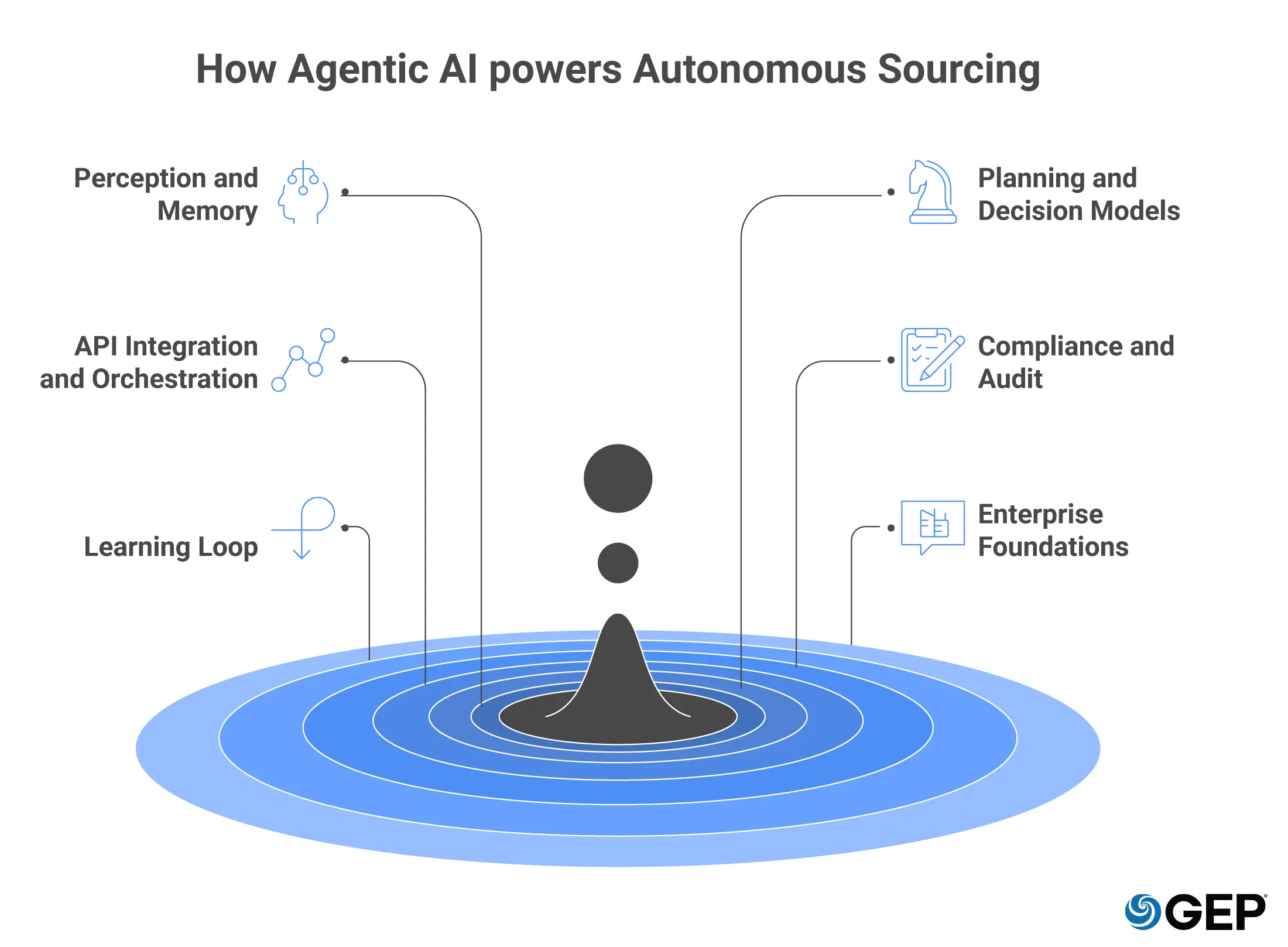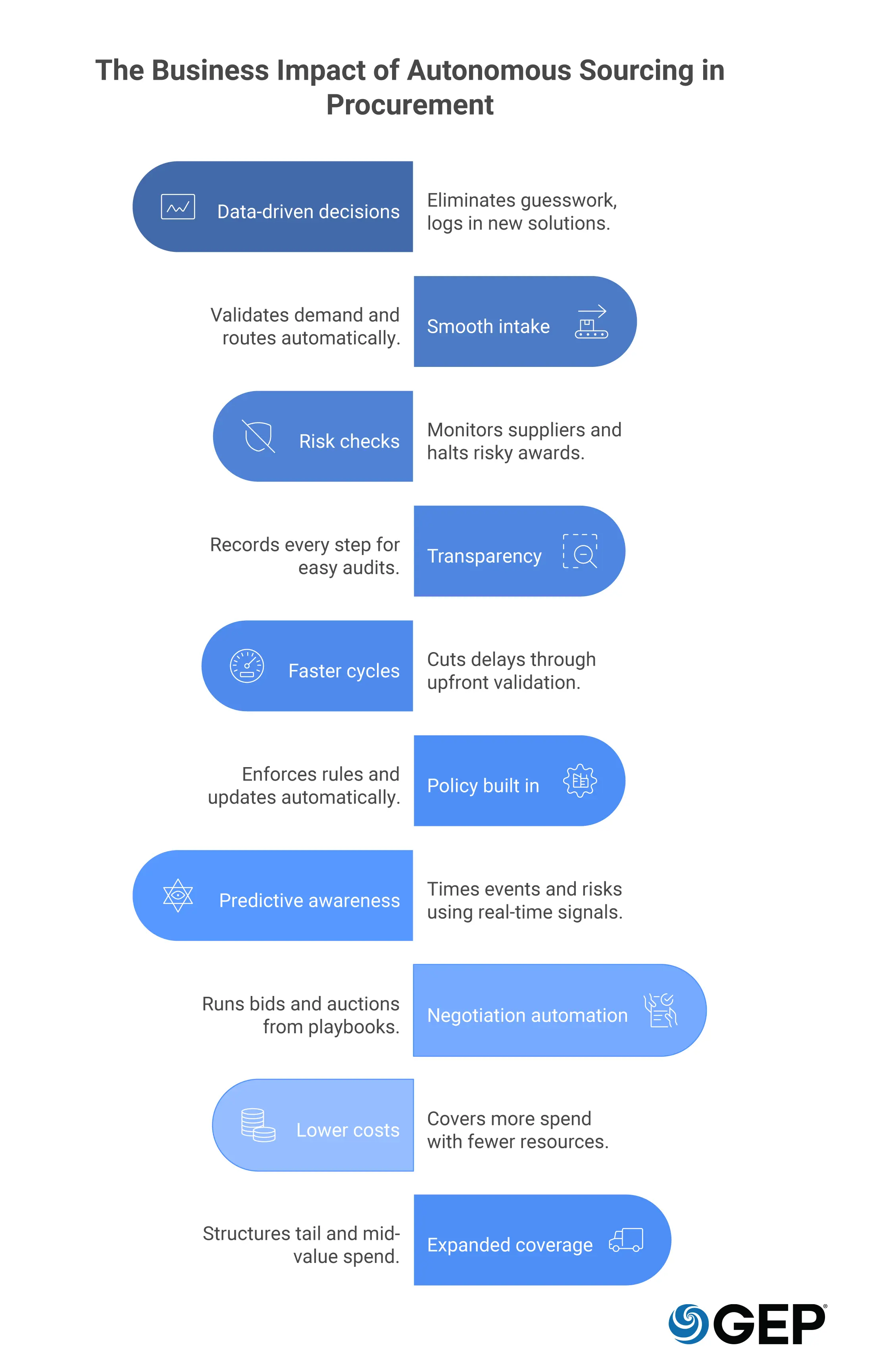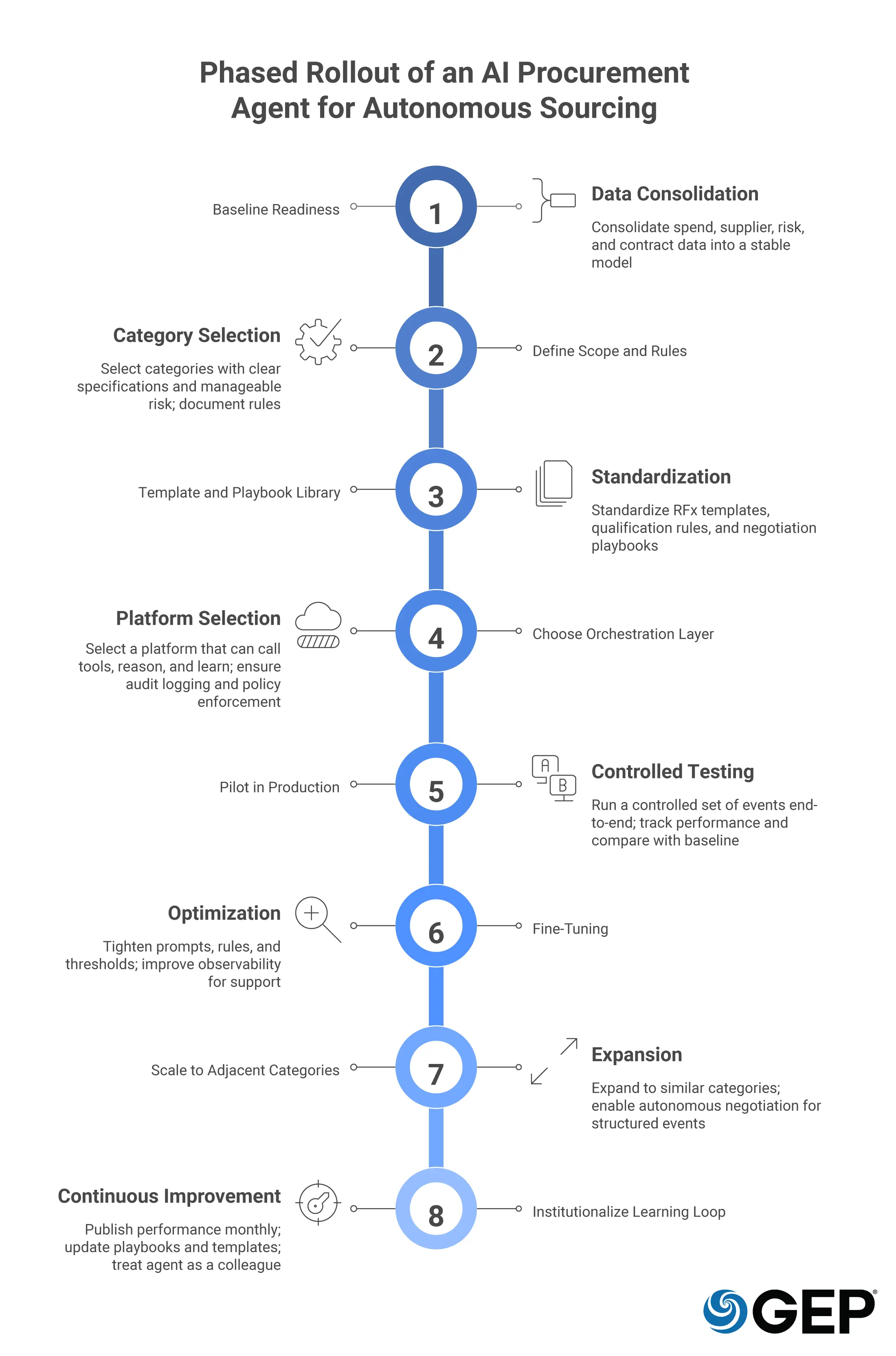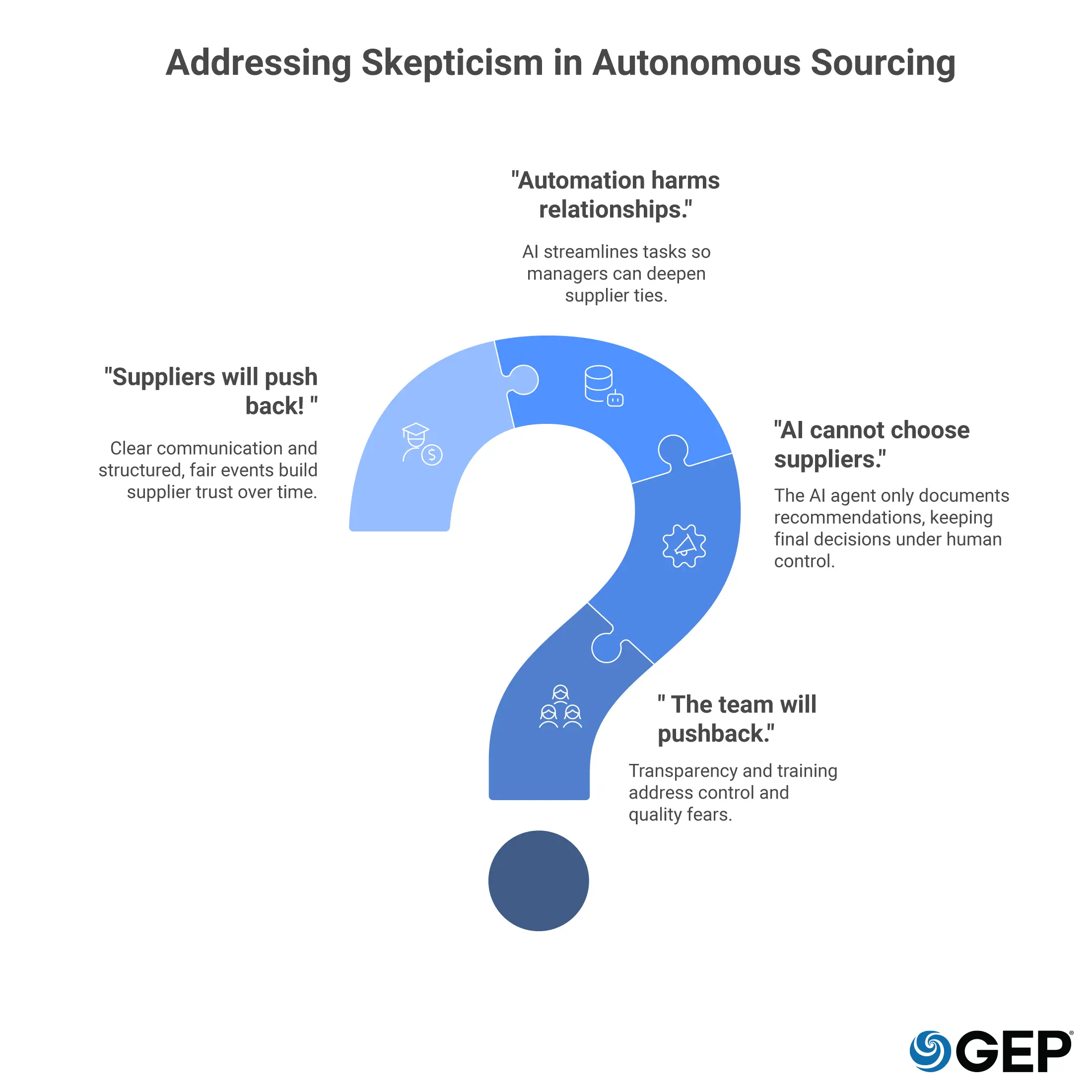
The Thinking Layer in Procurement: Agentic AI for Autonomous Sourcing
- Agentic AI brings in a ‘thinking layer’ that manual sourcing never offered.
- It reacts to risk and moves with the market, so sourcing decisions stay sharp when the pressure’s highest.
- Autonomous sourcing with agentic AI is built for this.
October 01, 2025 | Sourcing Technology 7 minutes read
Enterprises are under pressure. Budgets are tighter amid changing tariffs, and geopolitical tensions rise. Risk is harder to manage, and procurement is expected to cut costs while keeping the supply base steady. Manual sourcing simply doesn’t hold up under that pressure. Autonomous sourcing is the smartest response to that gap.
Agentic AI in sourcing adds a thinking layer that manual sourcing never had.
Amid market weaknesses, leaders must identify negotiation opportunities, taking advantage of spot buying for essential goods and services.
For procurement to be strategic in sourcing, it needs a system that anticipates risks, responds to disruptions, and course-corrects without human intervention to keep operations moving.
This article outlines what autonomous sourcing is and how procurement leaders can adopt a practical approach to strategic sourcing using agentic AI.
What Is Autonomous Sourcing?
Autonomous Sourcing is a cognitive system that plans, runs, evaluates, and awards events across categories using policy-safe measures, using predefined templates and rules, but is not limited to them.
The system senses demand, analyzes risk, plans the event, and executes the source-to-pay cycle end-to-end, learning from results while still acting within guardrails.
Agentic AI doesn’t simply guess its next move but acts on data-driven insights and the historical data it has been trained on. When in doubt, i.e., before making any major decision that hasn’t transpired in the past, it seeks validation from a human agent, making it safe and reliable to employ.
Talk to our Expert
How Agentic AI Differs from Gen AI and Narrow AI Agents
General-purpose Gen AI understands and generates language, while traditional AI agents follow predefined rules in a narrow lane. But agentic AI goes further.
It plans goals, formulates strategies, reasons for outcomes, and monitors progress while adjusting steps as reality shifts. The difference shows up in day-to-day operations.
Narrow AI agents check boxes within predefined workflows, while agentic AI orchestrates work across systems and teams and optimizes the entire flow. It applies risk, compliance, and cost analysis at each step and finishes the job without constant handholding.
While people use "assistants," "AI agents," and "agentic AI" interchangeably, their core operating behavior is not the same.
Assistants help a user get a task done. Narrow agents execute a scripted task. Agentic AI is responsible for setting the task list, executing tasks, and making adjustments when variables change. It is the missing layer that turns automation into reliable execution at scale.
The Role of Agentic AI in Autonomous Sourcing

Perception and memory
The system takes in demand signals from intake forms, contracts, catalogs, and ERP data. It then adds in external inputs such as market indices, sanctions lists, and supplier disclosures. The memory is both short-term and long-term, so the learning from one sourcing event isn’t lost when the next one begins. Because the models combine reasoning with multimodal understanding, they remember context and adapt across events.
Planning and decision models
Once the information is in place, a planning layer converts policy and category strategy into a set of actions. It decides what type of sourcing event makes sense by using optimization or scoring models. It can even recommend negotiation tactics while making sure the steps stay within policy and contractual boundaries. Instead of being reactive, the system acts like a strategist working from a clear playbook.
API integration and orchestration
The agent calls services the way a seasoned buyer would. It pulls templates from contract lifecycle management (CLM), issues RFQs in the sourcing application, runs checks, and writes back clean data into the payment layer.
Compliance and audit
Every action is recorded. The system checks ESG commitments, validates data residency, and enforces segregation of duties. That record creates a reliable audit trail that holds up under SOX, GDPR, or ISO-aligned audits.
Learning loop
The agent looks back at win rates, cycle times, and actual savings versus projected targets. Those results feed into the database, so the next round runs smarter. Research shows that leaders who adopt this type of continuous loop are moving beyond small pilots and into scaled, AI-enabled operations. Without that feedback cycle, gains tend to fade. With it, they compound.
Enterprise foundations
The infrastructure comes from the big providers like Microsoft, AWS, and Google, that host the models and provide the guardrails. Underneath, a unified data platform holds spend, supplier, risk, and contract records together. That consistency ensures the AI behaves predictably, following policy in the same way every time, regardless of category or buyer.
The Agentic AI Playbook for Procurement Pros
Your roadmap to moving from pilots to production, with AI that adapts, learns, and delivers
Why It Works: Tangible Business Impact
Autonomous sourcing with agentic AI shows up not as theory but as visible change on the dashboard and in the audit file.

Data-driven choices
Before each award, the agent reviews approved price bands, lead times, and ESG disclosures. It compares supplier bids with cost models and prior history. Each decision is logged with evidence, which removes guesswork and speeds up reviews.
Smooth intake
Requests no longer bounce around. The agent validates demand, checks contracts or catalogs, and either routes to an existing agreement or starts an event. Stakeholders get visibility through integrated tools rather than chasing updates by email.
Ongoing supplier risk checks
The system re-checks sanctions, certificates, and media sources during events. It halts awards when risk scores cross thresholds and asks for mitigation steps when needed. Oversight remains in place for critical categories.
Full transparency
Every setup, invitation, and evaluation step is recorded with rationale. Audit does not depend on memory or personal spreadsheets. Teams preparing for compliance reviews spend far less time reconciling evidence.
Shorter cycle times
Delays drop because the agent validates data upfront, corrects minor errors, and routes around approval bottlenecks. Autonomous sourcing using agentic AI removes rework between steps.
Policy built in
Errors fall as each action is checked against the current policy. When ESG rules or approval thresholds change, the system updates automatically. This control makes it adapt to changing regulations on sustainability and reporting across regions.
Predictive awareness
The system tracks price indices, freight costs, and currencies. It can delay or bring forward events to protect margins. Moves are based on signals already collected but often unused by manual teams.
Negotiation automation
The agent runs structured bids and auctions based on playbooks. Multi-round events, timed bidding, or nudges toward target prices are all executed under control. Buyers spend more time on strategy and relationships and less on managing logistics. Research from Hackett and Spend Matters ranks this capability as near-term for procurement leaders.
Lower operating costs
Teams shift from manual checks to strategic oversight. More categories can be managed without adding headcount. Stakeholders see a consistent and predictable process. That reduces escalations and cuts support tickets.
Expanded coverage
Tail and mid-value spend finally receive structured sourcing. The agent designs right-sized events and ensures spending does not drift outside policy.
Implementation: How Companies Actually Roll It Out
A careful rollout beats a big-bang plan. The goal is production reliability. Follow a sequence that builds confidence and adoption.

Baseline readiness
Consolidate spend, supplier, risk, and contract data into a stable model. Map key policies.
Define scope and rules
Select categories with clear specifications and manageable risk. Document thresholds, approval paths, and escalation rules. Clarify when the agent can award, when it recommends, and when it stops for review.
Template and playbook library
Standardize RFx templates, qualification rules, evaluation criteria, and award models. Codify negotiation playbooks. Keep naming consistent across sourcing, CLM, and S2P so the agent does not stall on mismatches.
Choose the orchestration layer
Use a platform that can call tools, reason, and learn. Connect to a procurement software or the ERP suite in place. Confirm audit logging, policy enforcement, and model updates do not change behavior without review.
Pilot in production
Run a controlled set of events end-to-end. Track cycle time, coverage, policy adherence, and realized savings versus targets. Compare human-only baseline with agentic execution on the same category.
Fine-tuning
Tighten prompts, rules, and thresholds where the agent over-escalates or under-reacts. Stabilize input data. Add retries. Improve observability so support can diagnose quickly.
Scale to adjacent categories
Expand to similar categories. Introduce more complex award models. Turn on autonomous negotiation for structured events. Keep humans on exceptions and strategic relationships.
Institutionalize the learning loop
Publish performance monthly. Feed outcomes back to playbooks. Update supplier pools. Refresh templates when legal updates clauses. Treat the agent like a colleague who benefits from coaching and clear goals.
Addressing The Skepticism

Suppliers will push back
Structured, predictable events reduce friction. Suppliers prefer clear timelines, clean data, and consistent criteria over ad hoc processes. Standardization improves trust over time, especially when the same rules apply to all.
Automation harms relationships
Autonomous sourcing handles repetitive steps. Category managers keep ownership of strategy, innovation, and performance reviews. That balance improves capacity for meaningful conversations with key suppliers.
AI cannot choose suppliers
High-risk awards stay under human control. The agent recommends and documents rationale. Reviews become faster because evidence is prepared. That is safer than subjective judgment buried in inboxes. Hackett’s findings on ethics, governance, and readiness match this control pattern.
The team will push back
Change is real. Colleagues worry about control and quality. Address it with clarity and skill-building:
- Explain where the agent acts and where humans decide.
- Train teams on reading agent rationales and challenging them with evidence.
- Update performance goals to reward policy adherence and business outcomes.
- Create a feedback channel that improves the agent quickly. People adopt what they can shape.
Involve legal, risk, audit, and IT early. Document who approves policy changes. Keep a change log so behavior is never a mystery.
Conclusion
Agentic orchestration is the logical step that turns disparate procurement into a smooth and reliable orchestration. Leaders do not need to attempt everything at once.
- Start where data is strong and risk is modest.
- Prove that the agent executes to policy.
- Expand methodically before you release the results.
And lock in the wins!
Automate the complete source-to-pay process in a unified platform with GEP SMART. Request a demo.



